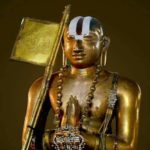அடியேன் நமஸ்காரம்
இன்றைய வேளுக்குடி ஸ்வாமியின் என் பணி 2617 சொல்லும் பொழுது நமக்குள் உட்கட்சி பூசல் இருந்தது எல்லோரும் அறிந்ததே ,சிதம்பரம் ஒரு உதாரனம் மற்றொரு உதாரனம் கீழே கொடுத்துள்ளேன் இது கும்பமேளா உஜ்ஜையினி சம்பவம் பிரிட்டிஸ் காலம் மற்றும் அதற்க்கு முன்பும் பெரும் கலவரம் வைனவர்கள் மற்றும் சைவர்கள் இடையே ஏற்பட்டது
மேலும் வாத பிரதிவாத போர் மற்றும் அதன் தீர்ப்பை ஒட்டி நடந்த போர் இவையனைத்தும் விக்கிபீடியாவில் உள்ளது,லிங்க் கிழே
இது போன்ற சமயங்களில் வீர வைஷ்ணவ் தேவை
கொசுறு செய்தி தோதாத்ரி மடம் என்பது நாங்குநேரி மடம் (கீழே வாத பிரதிவாதத்தில் ஈடுடபட்டவர் தோதாத்திரி மடம் என்று உள்ளது)
British era
During the British rule, the Ujjain Simhastha was the only Kumbh Mela organized in a princely state. While Haridwar, Prayag and Trimbak-Nashik were part of the territories directly ruled by the British, Ujjain was part of the Gwalior State ruled by the Scindia (Shinde) dynasty. During this time, the Scindias financed half of the event’s expenses.[1]
At the 1826 fair in Ujjain, a sectarian conflict took place between the Saivite Gosains and the Vaishnavite Bairagis. The Gosains, who started the clash, were defeated.[7] Their monasteries and temples were plundered by the Bairagis, who were assisted by the local Marathas.[8]
The militarized sadhus were disarmed during the British era. An 1850 British account mentions that the administrators of Ujjain sought British military help to prevent violence between Gosains and Bairagis. In response, two companies of the Gwalior Infantry were deployed in Ujjain under the command of Captain Macpherson. A fenced barrier was constructed in the middle of the shallow river so that the two groups could bathe independently of each other instead of fighting over ceremonial precedence. One hundred Brahmins were positioned along to fence to assist the sadhus in their ablutions. Macpherson deployed his troops throughout the city, on the bathing ghats and in the temple balconies. He convinced the Saivites to conclude their bathing rituals in morning, before the arrival of much larger and more powerful Vaishanavite group. As a precaution, he also deployed heavy guns along the river to curb any potential violence. There was a dispute between two Vaishnavite sub-groups, which was resolved by Macpherson without violence.[8]
The 1921 Simhastha is notable for a historic debate in which the Ramanandi Sampradaya defeated the Ramanuja sampradaya (Shri Vaishnavas). The debate was to address the question whether the Shri Vaishnava literature offended Ramachandra. The Ramanuja sampradaya was defended by Swami Ramprapann Ramanujadas of the Totadri math. The Ramanandis were represented by Bhagavadacharya (alias Bhagvad Das). The jury declared Bhagavadacharya as the winner of the debate, and Ramanandis became independent of the Ramanuja sampradaya. However, some Ramanandis continued to regard themselves as part of the Ramanuja sampradaya, alleging that Bhagavadacharya forged evidence used to win the debate and that the jury was biased. The Ramanujis were prohibited from participating in the subsequent 1932 Kumbh Mela at Ujjain.[9


